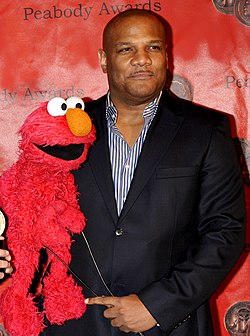
The Sesame Street Muppets are a group of puppet characters created by Jim Henson, many for the purpose of appearing on the children's television program Sesame Street . Henson's involvement in Sesame Street began when he and Joan Ganz Cooney, one of the creators of the show, met in the summer of 1968, at one of the show's five three-day curriculum planning seminars in Boston. Author Christopher Finch reported that director Jon Stone, who had worked with Henson previously, felt that if they could not bring him on board, they should "make do without puppets". [1]
Contents
Henson was originally reluctant but agreed to join Sesame Street in support of its social goals. He also agreed to waive his performance fee for full ownership of the Sesame Street Muppets and to split any revenue they generated with the Children's Television Workshop (renamed to Sesame Workshop on June 5, 2000), the series' non-profit producer. [2] The Muppets were a crucial part of the show's popularity and it brought Henson national attention. [3] The Muppet segments of the show were popular since its premiere, and more Muppets were added during the first few seasons. The Muppets were effective teaching tools because children easily recognized them, they were predictable, and they appealed to adults and older siblings. [4]
During the production of Sesame Street's first season, producers created five one-hour episodes to test the show's appeal to children and examine their comprehension of the material. Not intended for broadcast, they were presented to preschoolers in 60 homes throughout Philadelphia and in day care centers in New York City in July 1969. [5] The results were "generally very positive"; [6] children learned from the shows, their appeal was high, and children's attention was sustained over the full hour. [5] However, the researchers found that although children's attention was high during the Muppet segments, their interest wavered during the "Street" segments, when no Muppets were on screen. This was because the producers had followed the advice of child psychologists who were concerned that children would be confused if human actors and Muppets were shown together. As a result of this decision, the appeal of the test episodes was lower than the target. [6] [7]
The Street scenes were "the glue" that "pulled the show together", [8] so producers knew they needed to make significant changes. The producers decided to reject the advisers' advice and reshot the Street segments; Henson and his coworkers created Muppets that could interact with the human actors, [8] [9] specifically Oscar the Grouch and Big Bird, who became two of the show's most enduring characters. [10] These test episodes were directly responsible for what Canadian writer Malcolm Gladwell called "the essence of Sesame Street—the artful blend of fluffy monsters and earnest adults". [8] Since 2001, the full rights for the Muppets created for Sesame Street (which do not include Kermit the Frog) have been owned by Sesame Workshop; [11] Sesame continues to license the trademarked term "Muppet" from The Muppets Studio for their characters.







